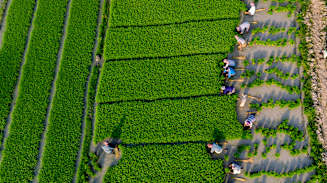
Collection

In 2025, the FAB industry finds itself at the intersection of multiple, compounding risks. Cost pressures are intensifying across the value chain — from raw materials and energy to logistics and labor — placing significant strain on margins. Sourcing ingredients has become more complex, and geopolitical tensions have escalated, disrupting trade flows and increasing volatility. Ransomware attacks have doubled across the sector since 2024,1 while food safety incidents have spiked and climate-related disruptions continue to destabilize already strained supply chains.
Yet amid this volatility, leading organizations are not standing still. They are rethinking risk, reconfiguring operations, and unlocking new opportunities for growth and resilience.
According to Aon’s Global Risk Management Survey, FAB leaders have identified the following as the top ten risks facing their organizations today:

Collection
These risks rarely occur in isolation. A cyber attack can trigger a business interruption event. A natural disaster can shut down a key port, leading to supply chain failure and commodity shortages. The ripple effects of one incident can cascade across operations and markets and can affect reputation and brand. Understanding how these risks correlate and modeling their potential impact is essential for building resilience and identifying strategic opportunities.
Volatility in ingredient and retail prices remains a persistent challenge for the FAB industry, driven by trade tensions, conflicts and climate disruption. This risk is prompting some organizations to reshape their product strategies, rethink long-term sourcing and even consider relocating crop production.
For those able to anticipate and model these fluctuations, there is opportunity. Scenario modeling and correlation analysis allow leaders to stress-test exposures, optimize procurement strategies and strengthen supplier relationships — sometimes even turning volatility into a competitive advantage.
Climate-related events continue to affect crop yields and logistics, prompting FAB organizations to adopt forward-looking modeling tools to assess future production viability. These insights are helping leaders explore direct sourcing and even production relocation — strategies that, while long-term and complex, offer greater control and resilience.
Subtle climate shifts, such as warmer rainfall patterns which increase crop disease risk, are also influencing decisions on factory locations and long-term investment. By understanding how climate, logistics and geopolitical risks interact, companies can make smarter decisions about where and how to invest in supply chain infrastructure, positioning themselves ahead of competitors that react rather than plan.
This risk remains a key concern for the FAB industry. Reputational damage is often the downstream effect of other major risks: business interruption, supply chain failure, cyber attacks and food safety incidents can all trigger public scrutiny and erode consumer trust. While the potential for reputational harm is significant, it also presents an opportunity for organizations to stand apart.
Companies that proactively invest in predictive analytics and integrated risk response frameworks can mitigate the impact of incidents and build consumer trust through transparency and operational excellence. In a market where brand integrity is a key differentiator, this can become a source of competitive advantage.
The next three years aren’t expected to see stabilization in the industry. Instead, by 2028 FAB leaders expect cyber risk, digitalization and geopolitical volatility to rise in importance, with climate change and commodity inputs continuing to be challenges:
The rise of AI and automation is reshaping production and supply chain management. These technologies are unlocking new efficiencies and enabling real-time decision-making, but they also introduce new vulnerabilities. Ransomware attacks are becoming more frequent and more costly — not just in terms of ransom payments but also due to supply chain disruption and subsequent business interruption. A recent example cost a UK retailer an estimated $400 million in lost operating profits over a 15-week period.2

Global Risk Management Survey
According to our survey, 88 percent of FAB leaders say AI increases their cyber exposure and 91 percent believe their workforce needs new skills to manage digital transformation.
These findings underscore that digitalization is not just a technology challenge — it’s also a human capital one. As digital tools become central to operational efficiency, product safety and resilience, organizations must equip their people to lead through change, manage emerging risks and unlock the full value of innovation. At the same time, the industry’s growing reliance on technically skilled talent is intensifying competition for expertise and putting pressure on organizations to rethink recruitment, training and retention strategies.
To thrive in this environment, FAB leaders must take a dual approach: investing in secure, scalable digital infrastructure while also building a future-ready workforce. Those who succeed will be the ones who treat digitalization as a strategic lever for resilience and growth.
Trade tensions, regional conflicts and cost pressures are compounded by unpredictable events such as port strikes and vessel seizures, and FAB leaders expect these types of challenges to persist. These disruptions can delay shipments of perishable goods, often excluded from standard insurance coverage, and lead to significant financial exposure. For example, China rejected 1,300 containers of Chilean cherries earlier this year due to delays,3 illustrating how fragile global logistics can be.
To manage this volatility, companies are revisiting supply chain strategies and adapting their insurance programs. Some are purchasing delay peril coverage to protect time-sensitive shipments from disruptions that fall outside standard policy terms. Others are conducting comprehensive reviews of materials, suppliers and processing operations to gain greater visibility into their supply chains.
Not all of the associated risks can be insured through traditional means. As a result, organizations are increasingly turning to captive insurance to manage uninsured exposures and tailor coverage to their specific risk profiles. Captives can play a strategic role in enhancing financial resilience, allowing companies to retain risk more efficiently and access broader coverage including through the reinsurance markets.
By embedding additional resilience into sourcing models and logistics planning, FAB organizations can safeguard continuity, enhance operational efficiency and protect their balance sheets against shocks.
of FAB industry respondents believe their workforce needs new skills to manage digital transformation
The most resilient organizations anticipate risk and leverage resilience, rather than just responding when an event occurs. They typically:
FAB leaders are leveraging data-driven insights to uncover hidden vulnerabilities across supply chains, quantify exposures in areas like cyber and climate risk, and model insurance program options.
By aligning these insights with their risk appetite and risk tolerance, organizations can make smarter decisions about which risks to retain, transfer or mitigate, as well as consider the use of captives and alternative risk transfer. This enables more efficient capital deployment and supports resilience, innovation and growth.4
Companies are actively monitoring systemic vulnerabilities across shared suppliers, regions, and logistics networks. Organizations are expanding sourcing strategies, developing regional supplier networks, partnering with growers and adopting parametric insurance solutions.
These actions help manage disruption and maintain continuity across their operations. This supports stronger business continuity planning and helps safeguard operations against cascading failures while enabling greater flexibility, faster recovery, and long-term resilience in the face of compounding risks.
In an industry shaped by disruption and transformation, resilience starts with people. Evolving business operations and future growth opportunities hinge on having a skilled workforce to help build success. From highly specialized technical talent to a dedicated and motivated manufacturing workforce, people can be the difference between an organization thriving or surviving.
By understanding how AI will reshape the world of work, organizations can better map future skills requirements against AI and industry-aligned taxonomies. This new era also requires an evolution of total rewards to help FAB organizations attract a new generation of talent.

Global Risk Management Survey
The FAB industry is at a pivotal moment. As competition intensifies for talent in AI, data science and digital operations, these capabilities are becoming essential not only for innovation but also for resilience. Real-time insights, predictive analytics and automation are helping organizations protect their operations and safeguard the global food supply.
Strategic use of AI-powered data, combined with expert guidance in risk transfer and human capital optimization, enables FAB leaders to understand their evolving risk profile. This supports smarter decisions around hiring, reskilling and investing in the capabilities that will drive future performance.
At the same time, shifting consumer preferences, driven by health trends and the rise of GLP-1 companion products, are prompting organizations to rebalance portfolios and reposition existing offerings. Demand is growing for high-protein, sustainable and wellness-oriented products, and organizations must act quickly to stay ahead of competitors.
Volatility is not a temporary condition but the new landscape that organizations find themselves in. Those that lead in this environment will be the companies that embrace complexity, embed resilience into every layer of their business, and act with clarity and confidence.
1 Q1 2025: Food and Ag-ISAC Ransomware Report
2 Britain's M&S restores click and collect services 15 weeks after systems hacked, Reuters
3 China to destroy 1,300 containers of Chilean cherries, Asiafruit
4 Mitigating Volatility and Maximizing Profits: A Guide to Risk Capital in the Food, Agribusiness and Beverage Industry, Aon
General Disclaimer
This document is not intended to address any specific situation or to provide legal, regulatory, financial, or other advice. While care has been taken in the production of this document, Aon does not warrant, represent or guarantee the accuracy, adequacy, completeness or fitness for any purpose of the document or any part of it and can accept no liability for any loss incurred in any way by any person who may rely on it. Any recipient shall be responsible for the use to which it puts this document. This document has been compiled using information available to us up to its date of publication and is subject to any qualifications made in the document.
Terms of Use
The contents herein may not be reproduced, reused, reprinted or redistributed without the expressed written consent of Aon, unless otherwise authorized by Aon. To use information contained herein, please write to our team.

Global Risk Management Survey
Financial institutions are navigating a landscape of converging risks, from cyber threats and regulatory complexity to economic volatility and geopolitical disruption. Leading organizations are adapting their risk strategies to build resilience, unlock growth and stay competitive in a fast-changing world.